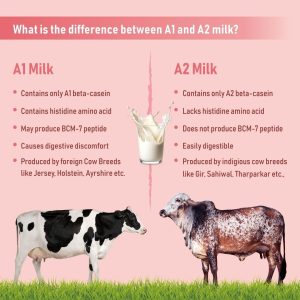What is the difference between A1 and A2 milk?

Difference between A1 and A2 milk:
A1 and A2 milk refer to two different types of milk based on the genetic variation of beta-casein protein found in cow’s milk. The key difference lies in the presence of specific variants of the beta-casein protein called A1 and A2 beta-casein.
A1 milk contains A1 beta-casein protein, which is a genetic variant found in the milk of certain breeds of cows, including Holstein Friesian, Jersey and Ayrshire. These breeds are commonly used in industrialized dairy farming.
A2 milk, on the other hand, contains A2 beta-casein protein, which is the original variant of beta-casein protein found in milk. It is primarily associated with indigenous cow breeds like the Gir, Sahiwal, Kangrej, Ongole, Khillari, Tharparkar, etc,.

The difference between A1 and A2 beta-casein lies in their amino acid composition. A1 Beta- Casein has a histidine amino acid at a specific position (position 67), whereas A2 beta-casein has a proline amino acid at the same position. During digestion, A1 beta-casein can be broken down into a peptide called beta-casomorphin-7 (BCM-7), which is believed to have certain effects on the human body.
According to some studies, BCM-7 may interact with the opioid receptors in the digestive system and potentially contribute to discomfort and digestive issues in some individuals. These issues can include bloating, gas, and gastrointestinal distress.
In contrast, A2 beta-casein does not produce significant amounts of BCM-7 during digestion. This has led to the belief that A2 milk might be easier to digest and less likely to cause digestive discomfort compared to A1 milk.
It’s important to note that individual responses to A1 and A2 milk can vary, and not all individuals experience adverse effects from consuming A1 milk. Some people may tolerate both types of milk without any issues, while others may notice a difference in their digestion or overall well-being when consuming A2 milk.
Related articles
Say Goodbye to Fake Jellies - Go Natural, Go Healthy!
Tiny Hands, Big Risks: Are We Feeding Our Children Health or Harm? Tiny hands reaching for colourful jellies - but are we giving them real goodness or a chemical cocktail? Today’s market shelves are bursting with glossy, bright jellies, but here’s the bitter truth: many of them are stuffed with chemicals that could impact your child's physical and mental growth. What once was a simple fruit preserve is now often a lab-made concoction. But don’t worry - natural fruit jellies are here to rescue snack time! The Hidden Ingredients in Market Jellies Gelatine: The unseen Animal Ingredient The majority of mass-produced jellies have Gelatine, an animal collagen-based substance. Not the most palatable when you consider it, huh? Particularly for families who search for plant-based or healthier alternatives. Artificial Food Colours: More Harm than Colour Is that neon green or bright red? It's not from fruit - it's from synthetic colourants! Research has associated those artificial colours with behavioural issues such as hyperactivity in children. Sweetness Wronged: High-Fructose Corn Syrup Rather than natural fruit sweetness, most jellies contain high-fructose corn syrup, one of the primary causes of childhood obesity and sugar crashes. Natural Fruit Jellies: What sets them apart? Real Fruit Pulp: Straight from Nature Natural fruit jellies are made with genuine fruit pulp - mangoes, palms, berries-delivering real flavour and nutrients in every spoonful. No Gelatine, No Worries These are Gelatine-free jellies, making them perfect for vegetarians and health-conscious parents alike. Clean Colours and Flavours With natural jellies, the colour you see comes from the fruit itself. No scary chemicals, no artificial tang - just the real deal. Nature’s colours. Nature’s flavours. Nature’s nutrition. How Additives and Gelatine affect Children’s health Gut Health and Digestive Issues Gelatine-heavy and chemically enhanced products can irritate the gut lining, leading to digestive issues over time. Behavioural Changes: The Hyperactivity Link Studies show a clear link between artificial food dyes and hyperactive behaviour in children - not something you want to deal with at homework time! Hormonal Disruptions: The Hidden Danger Synthetic additives have the potential to upset your child's hormonal equilibrium, which could impact their development and mental health. We are constructing futures rather than only filling bellies. Why Natural Jellies are the smarter choice for Kids Safe, Nutritious, and Naturally Tasty Natural jellies are free from harmful chemicals, letting you hand over a sweet treat without guilt. Immunity Boost in Every Bite Real fruits contain fiber, vitamins, and antioxidants - all the nutrients your growing child needs to remain strong and healthy. Eat smarter, shine brighter - it begins with the right choice. Spotlight on trusted Natural Jellies Alphonso Mango Jelly: The King’s Choice Made from the GI-tagged Alphonso mango, this jelly offers lush flavour and natural goodness - no fake stuff here! Mango Jelly: Pure, Sweet & Natural Crafted from real mango pulp, Mango Jelly delivers a summer-in-a-jar experience without any artificial aftertaste. Palm Jelly : Cooling and Nourishing Rare and precious, Palm Jelly (also known as Thati Thandra) is mineral-rich and naturally cooling - a perfect summer snack. Nature’s Trunk transforms nature’s seasonal fruits into timeless, guilt-free delights - one bite of jelly at a time. How to spot Real vs Fake Fruit Jellies Check the Ingredients List If you can’t pronounce half the ingredients, put it back on the shelf. Look at the Colour and Label Transparency Real jellies have softer, natural hues. Look for brands that are proud to show real fruit percentages and clean labels. Conclusion: Choose Health, Not Chemicals When you choose natural fruit jellies, you're gifting your child a little jar of health, not a science experiment. Reading labels, being aware, and choosing trusted options like Nature’s Trunk can make all the difference. Switch to natural - because their future deserves it! 👉 Try the real fruit magic with Nature’s Trunk - pure, delicious, and made with love for your little ones! FAQs about Natural Fruit Jellies Is Gelatine harmful to kids? Yes, Gelatine can cause digestive problems and is unsuitable for families seeking plant-based diets. How often can kids eat natural jellies? In moderation, daily small servings of natural jellies made from real fruits can be a healthy snack. Are artificial colours really dangerous? n fact, Artificial colouring has been linked to hyperactivity, allergies, and behavioural problems in kids. Can natural jellies replace candies? Absolutely! Natural jellies provide sweetness and nutrition without the sugar overload and chemical risks. What makes a jelly the best choice for children? Look for jelly that is not artificially coloured, made with real fruit pulp, natural sweeteners, and transparent ingredient labels.
Gulkand for Glow: The Ancient Ayurvedic Beauty Boost
The New Beauty Secret with Ancient Roots We're all searching for that natural glow, whether it's through pricey skincare regimens or endless beauty trends. However, what if your kitchen shelf holds the true key to glowing skin instead of your beauty shelf? Welcome to the world of Gulkand, a delightful Ayurvedic gem with a hint of rose that is making a modern resurgence. Thanks to the rising awareness around the gut-skin connection, Gulkand is now being embraced not just as a treat but as a natural glow remedy and a daily beauty ritual. What is Gulkand? A Simple Rose Remedy with Deep Ayurvedic Roots Gulkand (Rose Jam) is a traditional Indian preparation made by slowly blending fresh rose petals with natural sweeteners like rock sugar (Daga Mishri). Then it's sun-dried for days to seal in the flower's deep fragrance, nutrients, and natural oils. Rooted in Ayurveda, Rose Petal Jam is said to balance the Pitta Dosha, the governing system of body heat and metabolism. When this dosha is imbalanced (because of stress, spicy foods, or heat), it tends to manifest on our skin as acne, rashes, or dullness. How Gulkand helps your skin stay glowing and healthy Here’s why Rose Jam is more than just a sweet treat—it’s Ayurvedic skincare in a spoon. 1. It Detoxes from the Inside Out Gulkand gently flushes toxins from the body by supporting liver and gut health. When your system is clean inside, it shows on your skin - clearer, brighter, and more even-toned. 2. Cooling & Calming Effect on the Body Gulkand is deeply cooling. It helps reduce heat in the body, preventing breakouts, redness, and inflammation, common signs of excess Pitta. 3. The Gut-Skin Connection in Action Modern science now backs what Ayurveda said centuries ago: a healthy gut = healthy skin. Gulkand helps maintain good digestion, reduces acidity, and keeps your gut flora happy - all of which reflect positively on your skin. 4. Packed with Antioxidants and Anti-Inflammatory Properties Antioxidants are present in Rose Petals. These help fight free radicals that age your skin. Gulkand also reduces inflammation, making it helpful for acne-prone or sensitive skin. Why Gulkand with Nuts & Seeds is even better Nature’s Trunk takes this ancient recipe up a notch by adding nuts and seeds to Gulkand. Why does this matter? Essential fatty acids from seeds like flax and chia keep your skin hydrated and plump. Zinc from nuts helps in skin repair and acne control. Micronutrients like magnesium, selenium, and vitamin E support skin regeneration and that lit-from-within glow. It’s beauty nutrition, all in one spoon. Modern Skin Issues Need Traditional Solutions Processed foods, sugary snacks, poor sleep, and constant stress - all these show up on your skin as: Acne Dullness Redness Dryness Most quick-fix creams only treat the surface. Gulkand goes deeper, healing the root cause by calming your system, boosting digestion, and reducing internal heat. How to use Gulkand for skin benefits Getting that natural glow is easier than you think. Here’s how you can include Rose Gulkand in your daily routine: Morning Spoonful: Have 1 spoonful of Gulkand on an empty stomach. With Warm Milk: Before going to bed, mix it with warm milk to promote stronger digestion and overnight skin restoration. In Desserts or Smoothies: You can use it as a topping for pancakes and toast or add it to yogurt and smoothies! Mini FAQ: Gulkand for Skin 1. How long does it take to see results with Gulkand? Many people notice brighter, calmer skin in 2-4 weeks with daily use. 2. Can Gulkand help with hormonal acne? Yes, its cooling and hormone-balancing effects make it helpful for Pitta-related acne, especially during PMS. 3. Is it suitable for all skin types? Absolutely. Since it works from within, it helps all skin types, especially those with inflammation or sensitivity. Conclusion: Glow from Within, Naturally If you’re tired of chemical skincare and want something clean, delicious, and effective, Gulkand with nuts and seeds from Nature’s Trunk is the answer. It's a gentle, time-tested way to detox your skin, cool your system, and restore balance from the inside out. Ø Choose beauty that’s clean, calm, and Ayurvedic. Ø Try Nature’s Trunk Gulkand with Nuts & Seeds today and start your glow journey naturally.






